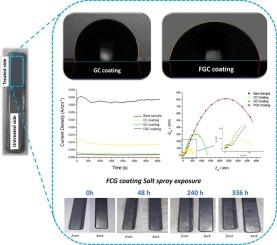Protective graphene-based coatings for Zamak: Physical and electrochemical analysis
IF 5.3
2区 材料科学
Q1 MATERIALS SCIENCE, COATINGS & FILMS
引用次数: 0
Abstract
Concerns surrounding the widespread use of hazardous materials have increased over time and have led numerous states to implement regulations aimed at preserving human and environmental health. In response, industries like metallurgy have gradually transitioned from traditional, hazardous technologies to safer alternatives, such as using polymeric coatings to protect metals from corrosion. This study focuses on evaluating the protective properties of non-functionalized graphene oxide-based coating (GC) and functionalized graphene oxide-based coating (FGC) on the zamak samples. First, the powders were analyzed from structural, morphological, and spectroscopic perspectives. The formation of amino-silica groups on the graphene oxide sheets was confirmed through SEM-EDS, XRD, and FTIR analyses, validating the success of the functionalization process. Granulometric analysis demonstrated a good dispersion of fillers in the mixtures. Cross's theoretical model was applied to the rheological experiments to find the optimum way of coating application on metallic substrates. The corrosion resistance of the coatings was evaluated using OCP, LSV, PS, EIS, and salt spray experiments. The results revealed that the functionalized graphene oxide coating provided superior corrosion protection compared to other coatings on Zamak samples. AFM topographic images, along with roughness measurements, indicated a significantly less corroded surface when using the functionalized graphene oxide coating. Additionally, Raman spectroscopy confirmed the protective effectiveness of the FGC coating against corrosion.

用于扎马克的石墨烯基保护涂层:物理和电化学分析
随着时间的推移,人们对广泛使用危险材料的担忧与日俱增,并促使许多国家实施了旨在保护人类和环境健康的法规。为此,冶金等行业逐渐从传统的危险技术过渡到更安全的替代技术,例如使用聚合物涂层保护金属免受腐蚀。本研究重点评估了非功能化氧化石墨烯涂层(GC)和功能化氧化石墨烯涂层(FGC)对扎马克样品的保护性能。首先,从结构、形态和光谱角度对粉末进行了分析。通过 SEM-EDS、XRD 和 FTIR 分析,确认了氧化石墨烯片上氨基硅基团的形成,验证了功能化过程的成功。粒度分析表明了混合物中填料的良好分散性。克罗斯理论模型被应用到流变实验中,以找到在金属基底上涂覆涂层的最佳方法。使用 OCP、LSV、PS、EIS 和盐雾实验评估了涂层的耐腐蚀性。结果表明,与 Zamak 样品上的其他涂层相比,功能化氧化石墨烯涂层具有更优越的防腐蚀性能。原子力显微镜地形图和粗糙度测量结果表明,使用功能化氧化石墨烯涂层后,表面的腐蚀程度明显降低。此外,拉曼光谱也证实了功能化氧化石墨烯涂层的防腐效果。
本文章由计算机程序翻译,如有差异,请以英文原文为准。
求助全文
约1分钟内获得全文
求助全文
来源期刊

Surface & Coatings Technology
工程技术-材料科学:膜
CiteScore
10.00
自引率
11.10%
发文量
921
审稿时长
19 days
期刊介绍:
Surface and Coatings Technology is an international archival journal publishing scientific papers on significant developments in surface and interface engineering to modify and improve the surface properties of materials for protection in demanding contact conditions or aggressive environments, or for enhanced functional performance. Contributions range from original scientific articles concerned with fundamental and applied aspects of research or direct applications of metallic, inorganic, organic and composite coatings, to invited reviews of current technology in specific areas. Papers submitted to this journal are expected to be in line with the following aspects in processes, and properties/performance:
A. Processes: Physical and chemical vapour deposition techniques, thermal and plasma spraying, surface modification by directed energy techniques such as ion, electron and laser beams, thermo-chemical treatment, wet chemical and electrochemical processes such as plating, sol-gel coating, anodization, plasma electrolytic oxidation, etc., but excluding painting.
B. Properties/performance: friction performance, wear resistance (e.g., abrasion, erosion, fretting, etc), corrosion and oxidation resistance, thermal protection, diffusion resistance, hydrophilicity/hydrophobicity, and properties relevant to smart materials behaviour and enhanced multifunctional performance for environmental, energy and medical applications, but excluding device aspects.
 求助内容:
求助内容: 应助结果提醒方式:
应助结果提醒方式:


